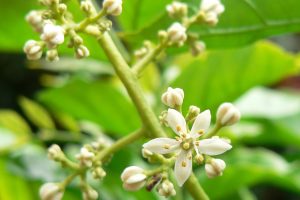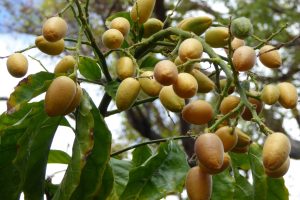Clausena lansium
Wampi, wampee
Origin
Southeast Asia
Climate
Sub-tropical, tropical, but cold hardy. Young and mature plants can survive air temperatures of -1 or -2°C without significant damage. It requires moisture to be maintained throughout the year, and while it can tolerate small amounts of salt spray, this is not the case for drought.
Plant Description
The plant is a low-branched evergreen large shrub or small tree reaching a height of about 6 m and is quite ornamental. The dark green resinous pinnate leaves are spirally arranged with 7-12 alternate elliptic leaflets, 7-10cm long, with minute hairs on the upper side veins and with a prominent yellow mid-rib on the under side.
Relatives
Rutaceae Family, which also includes citrus, white sapote and bael.
Soils
Undemanding of soils provided they are well-drained, with a preference for slightly acid to neutral pH conditions. It will still grow in alkaline soils but may become chlorotic, requiring Fe, Mn and Zn treatments. It can tolerate small amounts of salt spray.
Propagation
Propagation is easy and may be done by seed, cuttings, air layers or grafting. Seedling wampis are very variable, and the fruit may be small and sour. Wampis are very popular in Asia where there are many superior selections. However, they are very difficult to acquire in WA with our strict quarantine regulations against the importation of vegetative propagating material of citrus species and relatives.
Cultivars
Two cvs that are possible to source are Yeem Pay and Guy Sam.
Flowering and Pollination
It bears greenish-white perfect flowers in large terminal panicles in winter and early spring. Although self-fruitful, some fruit may have reduced seed numbers and this is improved with cross-pollination.
Cultivation
Plant in full sun. In the absence of specific studies on fertilization regimes etc, they can be managed similarly to citrus.
Wind Tolerance
Good.
Pruning
As fruit are produced in terminal panicles, care must be taken to minimise removal of fruiting wood with any pruning operations.
The Fruit
They are globose-ovoid berries, 1.5-3cm X 1-2cm, changing from pale green to yellow-brownish when ripe. The semi-translucent aromatic flesh is juicy, mucilaginous, sweet to sub-acid with 1-5 green seeds 10-15mm long. There may be more than 40 golden-brown fruits in a panicle. Some seedling-grown trees can produce very tart fruits.
Fruit Production and Harvesting
Trees will bear fruit in 3-6 years, although under poor conditions they may take considerably longer. Fruit generally mature in summer and they should be carefully picked with the stem attached to minimise post-harvest fungal rot.
Mature trees can yield 30-40kg of fruit pa.
Fruit Uses
The fruit is most often used for fresh consumption. It can also be used for making jellies, jams, drinks, pies or other purposes. The fruits freeze well.
Pests and Diseases
Fruit flies, aphids, wooly aphids and sooty mould.
Comments
This fruit is rarely seen in WA, but on the east coast it is more common. Nevertheless, some of our enthusiastic members have managed to source them and more importantly, got them to fruit here. For fruiting in our hot dry summers, plants will need regular irrigation to keep moisture levels up. Try and get a named cv to ensure your efforts will be well-rewarded.

